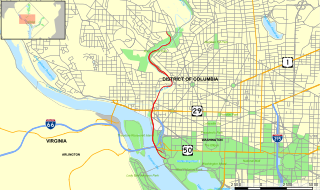
The Rock Creek and Potomac Parkway, often known simply as the Rock Creek Parkway, is a parkway maintained by the National Park Service as part of Rock Creek Park in Washington, D.C. It runs next to the Potomac River and Rock Creek in a generally north–south direction, carrying four lanes of traffic from the Lincoln Memorial and Arlington Memorial Bridge north to a junction with Beach Drive near Connecticut Avenue at Calvert Street, N.W., just south of the National Zoological Park.

Titusville is an unincorporated community located within Hopewell Township in Mercer County, New Jersey, United States. The area includes a post office with its own ZIP code (08560), several restaurants, gas stations, a firehouse, and a small village of homes. The Washington Crossing State Park, dedicated to George Washington's crossing of the Delaware River in 1776, is adjacent to the community.
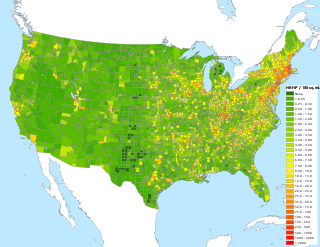
The National Register of Historic Places in the United States is a register including buildings, sites, structures, districts, and objects. The Register automatically includes all National Historic Landmarks as well as all historic areas administered by the U.S. National Park Service. Since its introduction in 1966, more than 90,000 separate listings have been added to the register.

The Pioneer Courthouse is a federal courthouse in Portland, Oregon, United States. Built beginning in 1869, the structure is the oldest federal building in the Pacific Northwest, and the second-oldest west of the Mississippi River. Along with Pioneer Courthouse Square, it serves as the center of downtown Portland. It is also known as the Pioneer Post Office because a popular downtown Portland post office was, until 2005, located inside. The courthouse is one of four primary locations where the United States Court of Appeals for the Ninth Circuit hears oral arguments. It also houses the chambers of the Portland-based judges on the Ninth Circuit.

Ohio City is one of the oldest neighborhoods in Cleveland, Ohio. It is located immediately west of the Cuyahoga River.
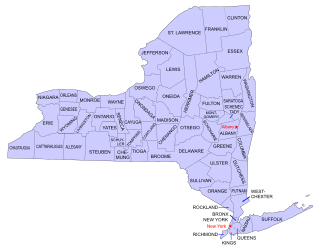
Buildings, sites, districts, and objects in New York listed on the National Register of Historic Places:

The Cahokia Courthouse State Historic Site is a reconstructed French-Canadian structure built about 1740 at what is now 107 Elm Street, Cahokia, Illinois. At various times it has served as a house and as a courthouse. It is currently interpreted to resemble its appearance about 1800 as a frontier courthouse of the Northwest Territory. The courthouse was listed on the National Register of Historic Places on November 9, 1972.

The Athens Governmental Buildings are a complex of buildings in central Athens, Ohio, United States. Among these buildings are the Athens County Courthouse, the Athens City Hall, and the former post office, now Haning Hall of Ohio University. The current post office is a much more recent building away from the town center, on East Stimson Avenue. Together, they were added to the National Register of Historic Places in 1979.

Downtown Fall River Historic District is a historic district on North and South Main, Bedford, Granite, Bank, Franklin, and Elm Streets in Fall River, Massachusetts.

New Fork is a ghost town in Sublette County, Wyoming, United States, near Boulder. It was one of the earliest settlements in the upper Green River valley. New Fork was established in 1888 by John Vible and Louis Broderson, Danish immigrants who had arrived in the United States in 1884. They established a store along the Lander cut-off of the Oregon Trail. By 1908 a small town had grown around the store, and in 1910 Vible built a dance hall, called The Valhalla.

The Ohio Company Land Office is one of the original buildings of the city of Marietta, Ohio, United States. The Office is listed individually in the National Register of Historic Places and as a contributing property to the Marietta Historic District.

The U.S. Post Office in Pearl River, New York, is located at the junction of Franklin and Main streets in the hamlet's downtown. It is a brick building from the mid-1930s, serving the ZIP Code 10965, which covers the hamlet of Pearl River.
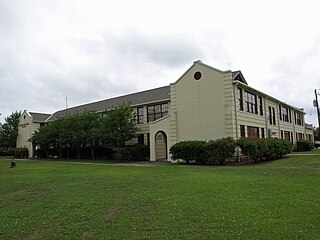
The Caldwell School is a historic former black school building in Mobile, Alabama. The school, originally named the Broad Street Academy, was the first public high school for African Americans in the city. It was founded in 1887, with William A. Caldwell serving as the first principal.

The Central of Georgia Depot in Andalusia, Alabama is a historic train station that has been converted into the Three Notch Museum.

Franklin Park is a neighborhood located on the Near East Side of Columbus, Ohio. Both the historic neighborhood and landmark, the Franklin Park Conservatory and Botanical Gardens, are named after the 88-acre park.

Plymouth Downtown Historic District is a national historic district located in Plymouth, Marshall County, Indiana, United States. The district encompasses 47 contributing buildings and one contributing structure in the central business district of Plymouth. It developed between about 1870 and 1940, and includes examples of Italianate, Romanesque Revival, and Colonial Revival style architecture. Located in the district is the separately listed Plymouth Fire Station. Other notable buildings include the Montgomery Ward Building (1929), Metsker Block, Rentschler Building (1910), Early Plymouth Post Office (1884), First National Bank-Plymouth City Hall, Packard Bank Block (1879), Simons Building (1895), Wheeler Block, Bank Block, Bank Block-Masonic Temple (1901), Plymouth Post Office (1935), and Plymouth Motor Sales (1929).

The Cedar Rapids Central Business District Commercial Historic District is a nationally recognized historic district located in Cedar Rapids, Iowa, United States. It was listed on the National Register of Historic Places in 2015. At the time of its nomination it consisted of 60 resources, which included 46 contributing buildings, one contributing structure, 12 non-contributing buildings, and one non-contributing structure. Cedar Rapids was platted on the east bank of the Cedar River as Rapids City in 1841, and it was incorporated under the same name in 1849. Kingston was established on the west bank of the river in 1852. The two smaller communities consolidated in 1870 as Cedar Rapids. The streets were laid out parallel and perpendicular to the river, which flowed from the northwest to the southeast. The Chicago, Iowa and Nebraska Railroad was the first to arrive in the community in 1859 and the tracks were laid on Fourth Street on the eastern edge of the central business district. The first bridge across the river was built at Third Avenue in 1871.
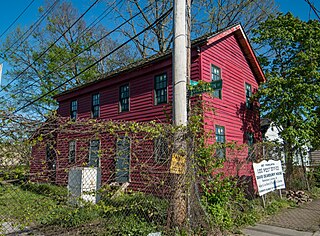
The Franklinton Post Office is a historic building in the Franklinton neighborhood of Columbus, Ohio. It was listed on the National Register of Historic Places in 1973. Also known as the David Deardurff House, it was built of hand-hewed logs by Deardurff in 1807. The two-story house sits on a limestone foundation. It is the oldest building in Columbus still on its original foundation. The building is on Gift Street, an area owned by Franklinton founder Lucas Sullivant, given to early settlers. The first post office in Franklinton was established here.
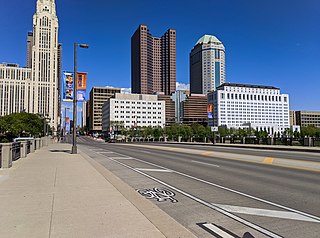
Broad Street is a major thoroughfare in Central Ohio, predominantly in Franklin County and Columbus. It stretches east from West Jefferson at Little Darby Creek to Pataskala. The street is considered one of Columbus's two main roads, along with High Street.





















